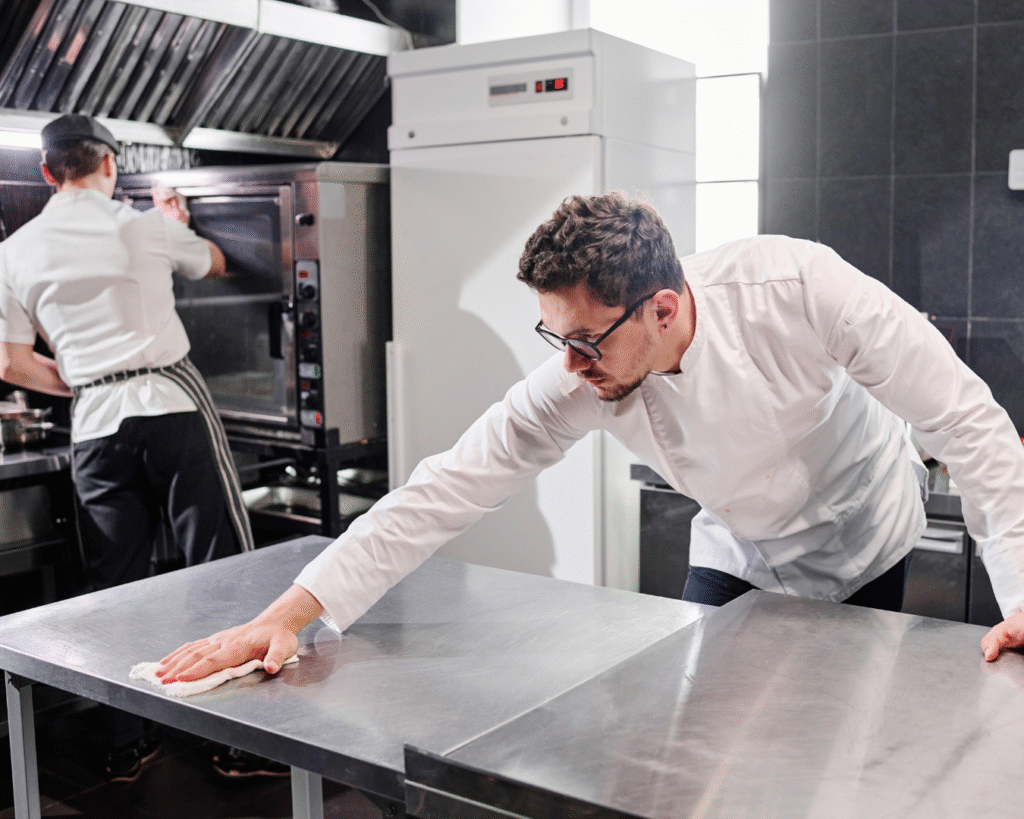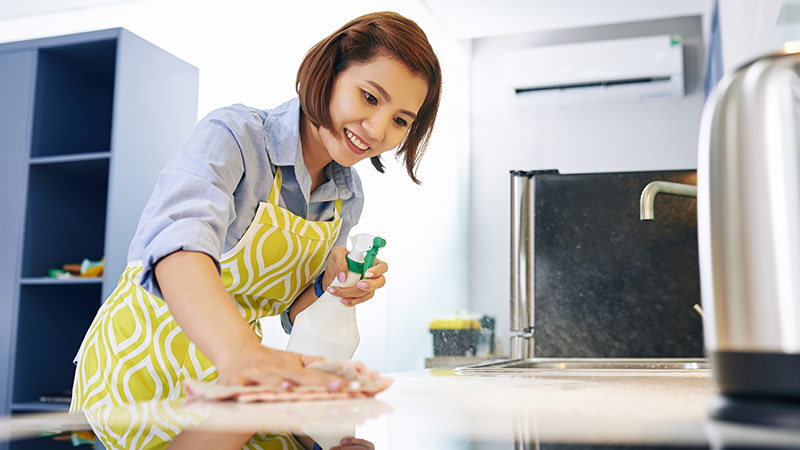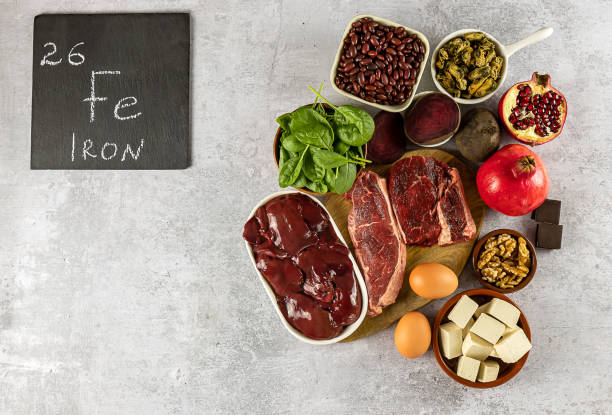Ensuring a pristine and safe space where you prepare your meals is essential for protecting your family from harmful bacteria and foodborne illnesses. A well-maintained kitchen not only boosts food safety but also lifts your spirit every time you cook a meal. With the rising concerns of cross-contamination and germ proliferation, you might find yourself asking, “Am I doing enough to support proper kitchen hygiene?” If your answer is anywhere less than a resounding yes, then this guide is for you. Dive into these actionable tips and transform your culinary space into a sanctuary of cleanliness and safety. And if you want to affect of poor hygiene , check this How Poor Hygiene Can Affect Your Health .
1. Establish a Daily Cleaning Routine

Developing a consistent cleaning regimen is the cornerstone of effective kitchen hygiene. Begin by wiping down countertops, stovetops, and sinks after each use. This habit prevents the buildup of food particles and grease that invite bacteria. You might consider the following routine:
- Wipe surfaces with a gentle yet effective disinfectant.
- Rinse with water and dry using a clean cloth.
- Keep a spray bottle handy with a solution of diluted vinegar and water for a natural cleaning boost.
By maintaining these daily practices, you ensure that each meal starts in a hygienic environment.
2. Prioritize Hand Washing
Hands are the primary carriers of germs and bacteria in the kitchen. Before handling any food or kitchenware, wash your hands thoroughly with soap and water for at least 20 seconds. This simple step is crucial for preventing cross-contamination. Consider placing a small reminder near your sink to encourage family members or roommates to adopt this practice every time they enter the cooking space.
3. Keep Surfaces and Utensils Germ-Free
Regularly cleaning and disinfecting kitchen surfaces such as cutting boards, countertops, and appliances is essential. Use a dedicated cleaning cloth for each area to avoid spreading microbes around. Pay extra attention to frequently touched handles, such as cabinet doors and refrigerator handles, as these can serve as hotspots for germ transfer. To make the process easier, establish specific times during the day to tackle this task and maintain a clutter-free kitchen.
4. Separate Raw and Cooked Foods

To reduce the risk of foodborne illnesses, it is vital to keep raw foods away from cooked or ready-to-eat dishes. Use separate cutting boards and knives for meats, vegetables, and fruits. This practice minimizes cross-contamination and helps preserve the nutritional value of your ingredients. A useful tip is to label and store raw and cooked foods in different sections of your fridge, ensuring they remain isolated even during storage.
5. Regularly Clean Kitchen Appliances
Appliances such as microwaves, ovens, and refrigerators can harbor residues and spills that contribute to an unhealthy environment. Make it a point to:
- Clean the inside of your microwave weekly, ensuring no food particles remain.
- Wipe down the refrigerator shelves and door seals regularly.
- Check behind appliances for accumulated dust and debris.
These habits not only keep your kitchen sparkling but also extend the life of your appliances and improve overall efficiency.
6. Keep a Clean Sink and Drain
The kitchen sink is often a breeding ground for bacteria if not maintained regularly. After washing dishes, take a moment to scrub the sink with a disinfectant or a mixture of baking soda and vinegar. Additionally, ensure that your drain is free of food scraps by using a sink strainer and periodically cleaning the drain with boiling water to dissolve any buildup.
7. Organize and Declutter

A cluttered kitchen makes cleaning a cumbersome task and creates hidden areas where dust and bacteria can accumulate. Organize your utensils, gadgets, and food supplies to keep work areas clear. Here are a few organizational tips:
- Use drawer dividers to separate utensils.
- Label storage containers for quick identification.
- Rotate pantry items regularly to avoid expired products.
An organized kitchen supports smooth cleaning processes and contributes to overall kitchen hygiene.
8. Choose the Right Cleaning Products
Invest in effective cleaning agents that are safe for your kitchen surfaces and food preparation areas. Look for products specifically designed for kitchen sanitation that can tackle grease and stubborn stains without leaving harmful residues. When shopping for cleaning products, consider the following:
- Read labels to ensure that the product is approved for kitchen use.
- Choose eco-friendly options that don’t compromise on efficacy.
- Maintain a small supply of everyday cleaning essentials so you’re always ready for a quick wipe-down.
Using the right tools and products makes it easier to adhere to a high standard of cleanliness and food safety.
9. Encourage a Culture of Safety Among All Kitchen Users
If you share your kitchen with family members or roommates, it’s crucial to promote practices that support good kitchen hygiene. Cultivate an environment where everyone understands the importance of cleanliness. You might consider:
- Organizing a weekly meeting to discuss improvements in the kitchen routine.
- Creating simple charts or checklists that outline daily and weekly cleaning tasks.
- Offering incentives for consistently following cleanliness guidelines.
When everyone in the household feels responsible, the kitchen becomes a shared space of safety and mutual respect.
10. Conduct Regular Deep-Cleansing Sessions
Beyond the daily cleaning routine, periodic deep-cleaning sessions are necessary to target stubborn dirt and grime. Once a month, set aside time to thoroughly clean areas that are often overlooked. A deep-clean might include:
- Removing and washing appliance filters.
- Cleaning behind large appliances.
- Scrubbing cabinet interiors and behind the sink.
- Washing walls and ceilings if necessary.
A deep-cleaning routine not only revitalizes your kitchen but also reinforces long-term commitment to kitchen hygiene.
Maintaining a hygienic kitchen is a continuous process that goes beyond surface cleaning. It’s about establishing routines, being mindful of every small detail, and actively involving everyone who uses the space. Integrating these ten tips into your everyday habits will significantly reduce the likelihood of contamination and ensure a safe cooking environment.
If you’re interested in exploring additional practices that align with this approach, check out How to Maintain Hygiene While Traveling for insights on sustaining a sanitary space even when on the move. As you continue your journey toward a cleaner, healthier kitchen, remember that each small step you take contributes to the overall well-being of your home.
For further in-depth resources on self-care, mindfulness, and personal growth, don’t forget to visit Venzec.icu.
By following these actionable strategies, you’ll create a space where food is not only prepared with love but also with utmost care for safety and cleanliness. Embrace the habit of perpetual improvement, and let your kitchen stand as a testament to the powerful impact of attention to detail. Enjoy the process of transforming your routine and share these tips with those who might benefit from a safer, more inviting cooking environment.










Leave a Reply